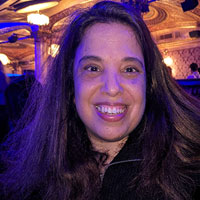When? June is the eye There was a child whom he preferred to build homes out of Lego bricks and sketch fiction. The journey with his father, who was a journalist, left a permanent impression on the young creative. “Seeing food, architecture, energy, created a curiosity about the world that lives with me,” they say. “I could live in Japan without that initial exposure, and looking back, it seems that those experiences helped build the foundation of my life in the design.”
Even though Aijaki used to dream of becoming an artist sometimes, but she always wanted to become an architect. He eventually moved to Brooklyn, New York, and received his bachelor’s degree from the Pratt Institute. He was a designer in the Rockwell Group, and then in 2004 established his multi -spoke studio CreamWhere he focuses on several projects from hospitality interiors to product design.
Crème \\\ photo Jun Aizaki: Taran wilkhu
Aizaki is as a storyteller as a designer. Their overall approach ensures that each element talks to another to increase a person’s interaction or to increase their relationship with an object. Inspiration comes not only from preferred places, but also from the customer or artists and their extended family of the fabricator.
Never less than ideas, the aejaki does not use both analog and digital methods to bring them down quickly. He still takes the traditional paper notebooks around because he believes that writing by hand is powerful. He also uses the Illustration app purchase on his iPad so that he can easily move from the pattern to the architectural diagrams between the text and the picture.
Aijaki also hugged the artisan through utensils, which he has discovered since his student days. He appreciates that this craft, unlike architecture, is completely touchable because anyone shapes a form with his hands. Nevertheless, both have a striking equality. “Both exercises share a general unexpectedness,” he notes. “You can design carefully, but the end results depend on the material, chemistry and teamwork. The feeling of cooperation is one that rewards these procedures for me.”
Today, June is a person connects for us Five FridaysTu
1. My motorcycle
I have motorcycles for my life. For me, they are about freedom, mobility and most important thing, capable of moving quickly and achieving things. Mobility, whether it is a motorcycle, a citybike/lime, or public transport, is so important for how we live. Anything that takes you around thrills me. I would eventually like to work on transport -related projects – this is an important part of urban life, and how the design can shape better, more connected communities, a natural expansion of it.
2. Knife collection
This traditional knife has been with me ever since I took it from my family home in Japan. What I love about it is how reliable it is. This is incredibly fast and easily accurate. When a device is well intensified and you can depend entirely on it, it is a great feeling. It is a beautiful object, simple and understanding, but is full of meaning. Every time I use it, it reminds me of the value of craftsmanship: the calm strength of something made with precise, discipline, and care.
Kurzgesagt beautifully creates animated videos that explain complex themes in a way that is accessible and visually hypnotic. A video of him is stuck with me “What is life?” – It takes the huge, philosophical questions and makes them tangible. I have always been designed for ways to tell stories that simplify the complexity of the world, and their work mixes the design, science and imagination in a way that is both fickle and deep.
4. Yunomi
My praise for ceramic has deep roots. My mother’s hometown in South -West Japan is famous for her Hagiyaki Pottery – one of the four historical earthen pot styles in Japan. It was a particular one that my father used a lot. It is a simple, beautiful item, which shows the petina of use: cracks, manufacturer’s fingerprints, layers of time. Objectively incomplete. It came in a pair and I accidentally broke one as a child, so it is even more meaningful that I now have the remaining one. Today, my relationship with ceramic – making and collecting both – takes me back from the history and tradition, and this is something that I continue to see through my work and hobby.
5. plants
I keep plants around my field because they remind a small but constant reminiscent of flexibility and development. It is attractive to me how a simple leaf can fall and start growing roots on its own. For me, plants are fun to take care, and they add a piece of nature to daily life. This relationship with nature also plays a big role in our work in Crame, where we always try to bring natural elements to our designs whenever we can.
June works by accepting and cram:
Brooklyn townhouse
This townhouse in Brooklyn is a study in renovation restraint, material honesty and layered crafts. External features retrieved the redwood siding obtained from a pre -water tower, which sets the tone for the design contained in the warm and calm intent. Inside, traditional Japanese effects are woven through a contemporary structure, creating a place that balances texture, natural light and thoughtful simplicity. A small treehouse tuned into the rear garden adds a fickle, unexpected layer.
Gourd project
Gourd project is an innovative initiative by Crame that examines the use of gourd grown in molds to make functional, biodegradable vessels such as cups and flask. The project resumes a centuries-old craft through a modern lens, which aims to produce permanent, renewable and fertilizer options for single-utilized plastic products.
Timber bridge
Crme for Timber Bridge proposes is a bridge connecting Brooklyn’s Greenpoint and Queens Long Island city. Pedestrian transit is designed to increase and make green space, the bridge aims to promote community connections and provide a safe, more enjoyable traffic for cyclists and pedestrians.

picture: Taran wilkhu
Sheraton kagoshima
Sheraton is the first international branded hotel in Kagoshima region. The design team took inspiration from the culture of the region, including the elements of the region’s history and traditions in the design. Artwork on various parameters, rich materials with natural tones and textures create an expansion of the city that contains attractive community locations that allow visitors to relax, meet or work.

picture: Erin Holsonback
Radform austin
Crème brought the fickle, market-driven of redfarm with a design for Austin on Chinese recipes, which makes fresh, energetic and communal. Using sophisticated materials and design elements, the space nodes for diverse cultural effects of both local regions and radforms, which creates a vibrant setting that complements the innovative menu of the restaurant.













